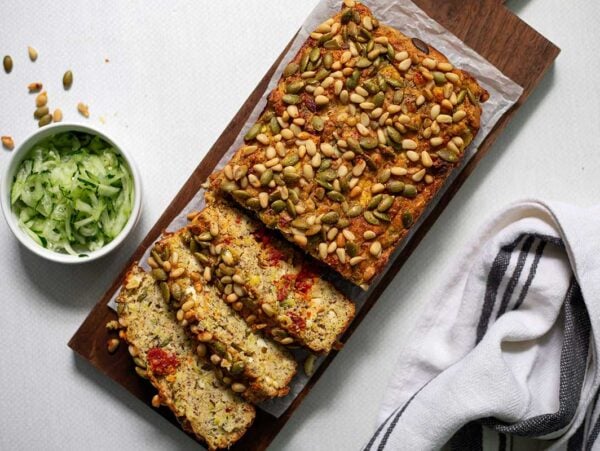4-Ingredient Sourdough Bread
Updated Mar 12, 2024, Published Aug 26, 2021
This post contains affiliate links. Please see our disclosure policy.
This 4-Ingredient Sourdough Bread recipe is a delicious way to start learning how to make sourdough baked goods. Be sure to read ALL the notes included at the end of the recipe before starting this and familiarize yourself with the sourdough process. See the description in the Sourdough Starter recipe below for more information about sourdough starter terminology.

4-Ingredient Sourdough Bread
Ingredients
- 200 grams un-fed gluten-free sourdough starter, (see notes)
- 420 grams gluten-free baking flour, (see notes)
- 300 grams bottled water, , cold or room temperature
- 12 grams kosher or fine sea salt
Instructions
Day 1 (Around 12 pm)
- Make the Dough: Add the un-fed starter, flour, water, and salt to the bowl of a stand mixer. Use the dough hook to mix until all ingredients are combined, the dough comes together, and there isn't any loose flour left.
- Bulk Fermentation: Gently form the dough into a ball and place in a lightly oiled and floured medium glass bowl. Loosely cover and leave in a draft-free place for 6-10 hours (6 hours if your house is on the warm side and up to 10 hours if your house is cooler). I generally let mine rise for about 8 hours. At this point, you don't want your dough to double in size.
- 2nd Proof (around 8pm): After the first rise, transfer the bowl to the refrigerator to finish proofing for 12 hours. You can keep the dough in the same bowl or you can gently reshape it and place it in a floured Banneton Basket.
Day 2 (Around 8 am)
- Place a Dutch oven on the center rack of the oven and preheat to 500°F. Let the Dutch oven preheat at 500°F for at least 30 minutes.
- When the Dutch oven has preheated, remove the dough from the refrigerator. Turn the dough out onto a piece of lightly floured parchment paper.
- With generously floured hands, gently re-shape to a tighter ball and use the flour to smooth the dough. The dough should be completely coated with a layer of flour. (Skip this if you proofed in a Banneton Basket.)
- Use a sharp knife or bread lame to slash the bread. You want the slash to be at least 1-inch deep. You can make it decorative or keep it simple to start and just do an X in the middle.
- Remove the Dutch oven from the preheated oven. Use the corners of the parchment paper to lift the dough and carefully place it in the Dutch Oven so you don't burn yourself. Place 2 large ice cubes in the Dutch oven between the parchment paper and sides of the Dutch oven and quickly cover with the lid.
- Place the Dutch oven back on the center rack and lower the temperature to 450°F. Bake for 40 minutes. After 40 minutes, lower the oven temperature to 425°F and then remove the lid from the Dutch oven. Bake for an additional 40 minutes, uncovered.
- When the bread is done, it should have an internal temperature of at least 210°F and the bottom of the bread should sound hollow when you knock on it. Cool completely on a wire rack before slicing and serving (it is important to cool it completely first).
Notes
- This recipe should not be made until the sourdough starter is mature, after day 14 but preferably at least a month old. An immature sourdough starter will not be able to leaven a loaf of bread. The day before baking, discard all but 25 g starter and feed it 100 g flour and 100 g water instead of the usual 75 g each. This will give you enough for the bread with enough left over to continue feeding as normal to maintain the sourdough starter.
- The sourdough starter used and tested in this recipe is made with Bob's Red Mill 1:1 Gluten-Free Baking Flour.
- For best results, use a high-quality gluten-free flour blend that already contains xanthan gum. To make this bread with a flour blend that doesn't contain xanthan gum, mix 15 g whole psyllium husk with the water and let it sit until it gels. Then mix the ingredients and follow the directions as indicated.
- Tap water can be subbed if it hasn't been chemically treated. Chlorine will kill the active cultures and wild yeast.
- This dough can be mixed by hand if you don't have a stand mixer. I use a Danish Dough Whisk to mix it.
- I finish proofing the dough in the refrigerator. It slows down the rise and helps prevent over-proofing your dough.
- I use a 5.5-quart Dutch oven to bake this bread. If you don't have a Dutch oven, you can use a cast-iron skillet and cover the bread with aluminum foil for the first half of the baking process.
- This bread is best served toasted. Think toast for breakfast, garlic bread, etc.
Nutrition
Nutrition information is automatically calculated, so should only be used as an approximation.

Sourdough Starter
Ingredients
- 25 grams gluten-free all-purpose flour
- 25 grams bottled or filtered water
Instructions
- Day 1: Add 25 grams gluten free flour and 25 grams water to a glass jar. Mix well and scrape down the sides the best you can.
- Day 2: No discard. Add 25 grams flour and 25 grams water.
- Days 3-6: Stir the starter and discard all but 25 grams of the starter. Add 25 grams flour and 25 grams water. Mix well and scrape down the sides the best you can.
- Days 7-10: Stir the starter and discard all but 25 grams of the starter. Add 50 grams flour and 50 grams water. Mix well and scrape down the sides the best you can.
- Days 11-14: Stir the starter and discard all but 25 grams. Add 75 grams flour and 75 grams water. Mix well and scrape down the sides the best you can.
Notes
- After day 14, you can continue to maintain this feeding schedule if you plan on baking with it soon.
- If you don’t plan on baking soon, store the starter in the refrigerator and maintain by discarding/feeding weekly.
- Do not keep an air-tight seal on your starter.
- Do not bake with the discard until the starter is at least 7 days old.
This Gluten Free Sourdough Bread recipe and directions on How to Make a Gluten Free Sourdough Starter can also be found on What The Fork Food Blog.













